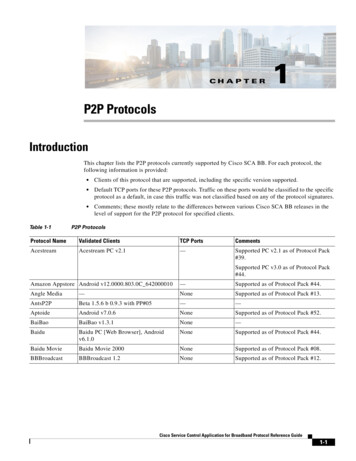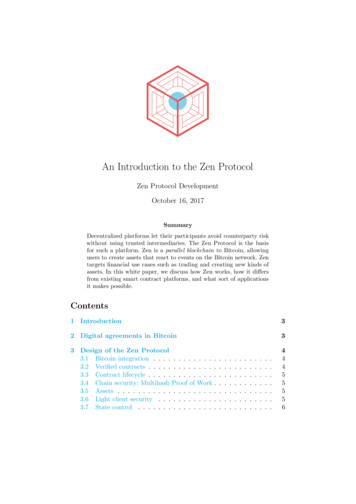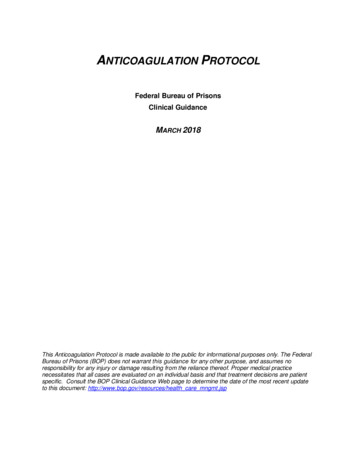
Transcription
ANTICOAGULATION PROTOCOLFederal Bureau of PrisonsClinical GuidanceMARCH 2018This Anticoagulation Protocol is made available to the public for informational purposes only. The FederalBureau of Prisons (BOP) does not warrant this guidance for any other purpose, and assumes noresponsibility for any injury or damage resulting from the reliance thereof. Proper medical practicenecessitates that all cases are evaluated on an individual basis and that treatment decisions are patientspecific. Consult the BOP Clinical Guidance Web page to determine the date of the most recent updateto this document: http://www.bop.gov/resources/health care mngmt.jsp
Federal Bureau of PrisonsClinical GuidanceAnticoagulation ProtocolMarch 2018WHAT’S NEW IN THIS DOCUMENT?The following changes have been made to the BOP Anticoagulation Protocol since it was last issued inApril 2013: A new table has been added to Section 4, Heparin Products. See Table 2. Dosing of LMWHs forTreatment and Prevention. In Section 5, Warfarin, the discussion has been expanded to include lifestyle factors and healthconditions affecting warfarin therapy. See Interactions with Food, Drugs, Lifestyle, and HealthConditions. A new Section 6 on Novel Oral Anticoagulants (NOACs) has been added. Information on Treatment of Deep Venous Thrombosis (DVT) and Pulmonary Embolism (PE) hasbeen updated in Section 7. The Inmate Fact Sheet on Warfarin is now available in Spanish. See Appendix 9B. The CHA2DS2-VASc score has replaced the CHADS2 score for predicting thromboembolic stroke riskin non-valvular atrial fibrillation. See Appendix 10, Table B.i
Federal Bureau of PrisonsClinical GuidanceAnticoagulation ProtocolMarch 2018TABLE OF CONTENTS1. PURPOSE . 42. OVERVIEW . 43. ANTICOAGULATION TEAM MANAGEMENT IN THE BOP . 5T ABLE 1. Safe Anticoagulation Management in the BOP . 64. HEPARIN PRODUCTS . 7Unfractionated Heparin (UFH) . 7Low-Molecular-Weight Heparins (LMWHs) . 7T ABLE 2. Dosing of LMWHs for Treatment and Prevention. 75. WARFARIN . 8Interactions with Food, Drugs, Lifestyle, and Health Conditions . 8Warfarin Dosing . 9INR Monitoring . 10Management of Patients with High INR Values. 10Management of Warfarin Dosing for Invasive Procedures . 11Dental Procedures for Patients on Warfarin Therapy . 12T ABLE 3. Dental Management of Patients on Anticoagulant Therapy . 136. NOVEL ORAL ANTICOAGULANTS (NOACS) . 14Direct Thrombin Inhibitors (DTIs) . 14T ABLE 4A. Dabigatran Dosing . 14T ABLE 4B. Conversions from and to Dabigatran . 15Selective Factor Xa Inhibitors . 16T ABLE 5A. Rivaroxaban Dosing . 16T ABLE 5B. Conversions from and to Rivaroxaban . 16T ABLE 6A. Apixaban Dosing . 17T ABLE 6B. Conversions from and to Apixaban . 17T ABLE 7A. Edoxaban Dosing . 18T ABLE 7B. Conversions from and to Edoxaban . 18Managing NOACs When Invasive Procedures are Required. 19T ABLE 8. Discontinuation of NOACs Prior to Invasive Procedures . 197. T REATMENT OF DEEP VENOUS T HROMBOSIS (DVT) AND PULMONARY EMBOLISM (PE) . 208. ANTICOAGULATION PROGRAM MANAGEMENT . 20REFERENCES . 21APPENDIX 1: ANTICOAGULATION CLINIC PROTOCOL . 23APPENDIX 2: CONTENTS OF SOAPE NOTES FOR ANTICOAGULATION T HERAPY . 27APPENDIX 3: RECOMMENDED INR T ARGET AND DURATION OF WARFARIN T HERAPY BY INDICATION . 28APPENDIX 4: WARFARIN INTERACTIONS . 29APPENDIX 5: WARFARIN INITIAL DOSING ALGORITHM . 30ii
Federal Bureau of PrisonsClinical GuidanceAnticoagulation ProtocolMarch 2018APPENDIX 6: WARFARIN DOSAGE ADJUSTMENT ALGORITHMS . 31APPENDIX 7: MANAGEMENT OF HIGH INR VALUES. 32APPENDIX 8: POINT-OF-CARE T ESTING PROTOCOL . 33APPENDIX 9A: I NMATE FACT SHEET ON WARFARIN . 34APPENDIX 9B: I NMATE FACT SHEET ON WARFARIN (IN SPANISH) . 36APPENDIX 10: G UIDANCE FOR MANAGING ANTICOAGULATION T HERAPY FOR PATIENTSREQUIRING I NVASIVE PROCEDURES . 39iii
Federal Bureau of PrisonsClinical GuidanceAnticoagulation ProtocolMarch 20181. PURPOSEThe purpose of this BOP Anticoagulation Protocol is to outline a recommended approach totherapeutic anticoagulation that minimizes the risk of both thromboembolic and bleeding events.This protocol is designed to guide clinicians in fulfilling the following objectives: Optimize anticoagulation benefits.Prevent adverse effects of warfarin therapy.Provide effective patient education and counseling.Improve patient compliance.2. OVERVIEWWarfarin, dabigatran, rivaroxaban, apixaban, edoxaban, and various heparin products are used inthe treatment and prevention of venous thromboembolism (VTE), as well as prevention of strokein patients with atrial fibrillation. Warfarin and heparin products are also utilized for themanagement of patients with cardiac valve replacements to prevent thrombosis and in selectpatients after myocardial infarction. Managing anticoagulation therapy is complex. Each patient’streatment must be individualized and monitored carefully.LOW-MOLECULAR-WEIGHT HEPARINS (LMWHS)The introduction of LMWHs has significantly improved outpatient anticoagulation therapy.The use of LMWHs has decreased the need for hospitalization—during initiation of warfarinfor treatment of acute VTE, as well as during “bridge therapy” when warfarin is temporarilyheld prior to invasive procedures. See more on heparin in Section 4.WARFARIN Warfarin is the primary agent for anticoagulation in the BOP. Warfarin therapy must be individualized and closely monitored. Warfarin is among the top 10drugs with the largest number of serious adverse event reports submitted to the U.S. FDA. Asa result, the Joint Commission has issued National Patient Safety Goals for anticoagulationtherapy. Warfarin has a narrow therapeutic index. Excessive or insufficient anticoagulation can haveserious and potentially life-threatening consequences, and the therapeutic response tomedication is not always predictable. Routine clinical evaluation of the patient, in addition tolaboratory monitoring, is essential because the International Normalized Ratio (INR) is animprecise and indirect measure of clinical effect. The effects of warfarin therapy are significantly influenced by patient-specific factors. Co-morbidities, age, diet, drug-drug interactions, and the patient’s adherence with the regimen allinfluence the effectiveness of the therapy and the risk of complications. The patient’scompliance with the therapy is crucial and requires that he or she understand the medicationregimen, the monitoring process, and possible side effects. Patients should receive intensivecounseling and education to promote adherence to the medication regimen; furthermore, theyshould be monitored to assess compliance. See more on warfarin in Section 5.4
Federal Bureau of PrisonsClinical GuidanceAnticoagulation ProtocolMarch 2018NOVEL ORAL ANTICOAGULANTS (NOACS)Dabigatran, rivaroxaban, apixaban, and edoxaban are the four NOACs currently approved by theFDA. These newer agents require less monitoring than warfarin since INR does not need to befollowed with these medications. Their optimal place in therapy is still under debate and iscurrently being investigated in clinical trials.Supplemental Chest Guidelines from 2016 (see Kearon, et al., under References) recommendthe use of NOACs as first line treatment for deep vein thrombosis (DVT), pulmonary embolism(PE), and VTE, instead of warfarin. However, the recommendations are not strong, only Grades2B and 2C. Many concerns still remain for the NOACs, including bleeding, monitoringparameters, drug interactions, and reversal agents. Within the BOP setting, patients should bemonitored closely to prevent major adverse events. The BOP will continue to use warfarin asthe primary agent for anticoagulation until stronger evidence is available on NOACs. See more on NOACs in Section 6.3. ANTICOAGULATION TEAM MANAGEMENT IN THE BOPSafe management of inmates on anticoagulation therapy requires rigorous, multidisciplinarycoordination and communication. Pharmacists and nurses can assist primary care providers byeducating inmates about diet modification and medication use—and by monitoring patients foradherence to treatment and any adverse drug reactions that might occur.Pharmacists, under Collaborative Practice Agreements approved by the Clinical Director and inaccordance with this protocol, can also order and review laboratory work and provide medicationmanagement. Pharmacist-managed anticoagulation clinics provide superior anticoagulation control withfewer anticoagulation-related side effects than standard management programs.Information on PROTOCOL PROCEDURES is provided in the following Appendices: Appendix 1 contains the BOP anticoagulation protocols, including information that should beobtained prior to providing anticoagulation therapy and the components of a clinic visit. As indicated in Appendix 1, Point of Care INR results should be entered into the electronicmedical record (BEMR) flow sheet. Patient education is critical to successful management of anticoagulation therapy. Keyinmate education messages are outlined in Appendix 1. Recommended contents for SOAPE notes are provided in Appendix 2. A fact sheet for inmates on warfarin therapy is provided in Appendix 9. Inmates who areprescribed dabigatran, rivaroxaban, apixaban, or edoxaban should be provided a separate patientinformation sheet. Fundamental elements of safe anticoagulation management in the BOP are summarized in TABLE 1.5
Federal Bureau of PrisonsClinical GuidanceAnticoagulation ProtocolMarch 2018TABLE 1. SAFE ANTICOAGULATION MANAGEMENT IN THE BOP #ELEMENTS OF WARFARIN MANAGEMENT1. Patient Management: Assign clear responsibility for individual patient management for eachinmate on warfarin2. Patient Education: Provide thorough and ongoing patient education regarding warfarin,warfarin drug-drug and drug-food interactions, the need for regular monitoring, and signs andsymptoms of bleeding or thromboembolism to report.3. Initial INR Testing: After warfarin is initiated, check the INR—ideally daily, but at least every3 days—until 2 consecutive results are within the therapeutic range. See Appendix 5, Warfarin Initial Dosing Algorithm. See Appendix 3, Recommended INR Target and Duration of Warfarin Therapy byIndication.4. Dosage Changes: Base warfarin dosage changes upon current INR results (i.e., within the last 48 hours). Use point-of-care INR testing when possible (e.g., CoaguChek XS Plus).5. Follow-Up INR Testing: Perform follow-up INR testing (preferably every 4 weeks, but can beup to 12 weeks for well-documented, stable and compliant patients). See Appendix 6, Warfarin Dosage Adjustment Algorithms.6. Other Medications or supplements: Check the INR after any drug or herbal medicine isadded or withdrawn, or the dosage has been changed.7. Transfers: For inmates on warfarin who are being transferred: Inmates must have a current INR* with no changes in warfarin dosing anticipated. When the INR is outside the therapeutic range, a decision to postpone transfer should bemade individually, based on a determination of clinical risk and medical stability. Receiving institutions should check the INR within 3 working days of transfer.8. New Intakes: Promptly obtain INRs and within 3 working days clinically evaluate all newintakes being prescribed warfarin.9. Invasive Procedures: Perioperative warfarin management should be carefully coordinatedwith the surgeon to minimize adverse outcomes. See Appendix 10, Guidance for Managing Anticoagulation Therapy for PatientsRequiring Invasive Procedures.10. Dental Procedures: Dentists should order an INR within the 72 hours preceding a dentalprocedure, and review the result with the inmate’s physician prior to performing theprocedure. See Dental Procedures for Patients on Warfarin Therapy in Section 5.* Current INR means an INR obtained at the frequency recommended in Appendix 6 and alwayswithin 12 weeks—preferably within 4 weeks.6
Federal Bureau of PrisonsClinical GuidanceAnticoagulation ProtocolMarch 20184. HEPARIN PRODUCTSUNFRACTIONATED HEPARIN (UFH)Use of UFH requires careful monitoring of the activated partial thromboplastin time (aPTT)because of UFH’s unpredictable anticoagulant effect. PLASMA ACTIVITY: Peaks 2–3 hours after parenteral administration. PROTOCOLS FOR MONITORING: Include testing every 6 hours to maintain an aPTT range of 1.5–2.5 times normal. Thus, UFH is administered only on an inpatient basis. ADVERSE EFFECTS: Include heparin-induced thrombocytopenia, defined as low platelet countsand a paradoxical hyper-coagulable state. Reversal of the anticoagulation effect of UFH is accomplished rapidly with IV protamine (1 mg per100 units UFH).LOW-MOLECULAR-WEIGHT HEPARINS (LMWHS)The LMWHs have a distinct advantage over unfractionated heparin in that they have a morepredictable anticoagulant effect. PLASMA ACTIVITY : Peaks 3–5 hours after subcutaneous injection. PROTOCOLS FOR MONITORING: Inmates treated with an LMWH should be monitored for heparin-induced thrombocytopenia if there has been no exposure to heparin products in the past.Patients with renal failure should be managed in expert consultation. If monitoring fortherapeutic levels is required, anti-factor Xa levels should be measured 4 hours afterinjections. As LMWHs are renally cleared, their half-life is lengthened in individuals with renal failure. For thisreason, LMWHs are contraindicated in hemodialysis patients. PREFERRED AGENT: Enoxaparin (Lovenox ) is the most commonly used LMWH and is theBOP-preferred agent. DOSING: See TABLE 2 below for dosing during treatment, bridging, and prophylactic use.Dosing of LMWHs for treatment is based on actual body weight. In morbidly obese patients(BMI 40 kg/m2), the prophylactic dose may be increased by 30% in some indications.TABLE 2. DOSING OF LMWHS FOR TREATMENT AND PREVENTIONTREATMENT OF DVT*, PE, AND DURING T HERAPEUTIC DOSE BRIDGINGNormal Renal Function (CrCl 30)Renal Impairment (CrCl 30) 1 mg/kg subcutaneously (sc) BID or 1.5mg/kg sc daily 1 mg/kg sc once dailyPREVENTION OF DVT*/PE (FOR MEDICAL, SURGICAL, AND ORTHOPEDIC PROCEDURES)Normal Renal Function (CrCl 30)Renal Impairment (CrCl 30) 40 mg sc once daily 30 mg sc BID (preferred for knee replacement) 30 mg sc once daily* For treatment of acute VTE, outpatient treatment with LMWHs has been found to be as safe and effective asinpatient care. See Section 7, Treatment of Deep Venous Thrombosis (DVT). If reversal of the anticoagulation effects of LMWHs is needed urgently, administer protamine 1 mgper 100 anti-factor Xa units. Note: Enoxaparin (Lovenox) 1 mg 100 anti-factor Xa units.7
Federal Bureau of PrisonsClinical GuidanceAnticoagulation ProtocolMarch 20185. WARFARINWarfarin is an oral anticoagulant that acts by inhibiting vitamin K-dependent coagulation factorsII, VII, IX, and X. It increases clotting time as measured by INR, a standardized measure of aprothrombin time (PT). Indications for the use of warfarin, therapeutic goals, and recommended duration of therapy areoutlined in Appendix 3.INTERACTIONS WITH FOOD, DRUGS, LIFESTYLE, AND HEALTH CONDITIONSPatients should be counseled to report any changes in diet, medications, or health status to theiranticoagulation provider. Numerous medications, foods, lifestyle changes, and health conditionscan either increase or inhibit warfarin effects. Below is a general description of some interactionswith warfarin. See Appendix 4, Warfarin Interactions, for a detailed list.DIET Foods that interact with warfarin are typically high in vitamin K, especially green leafyvegetables. Individuals on long-term warfarin therapy are sensitive to fluctuating levels ofdietary vitamin K. Patients should know that they need to eat such foods in moderation andavoid large fluctuations in intake. Per the 2012 ACCP guidelines, routine use of vitamin K supplementation for varying INR isno longer recommended.MEDICATIONS AND SUPPLEMENTSNumerous drugs interact with warfarin, either increasing or decreasing the anticoagulant effect. It is recommended that the INR be checked whenever any new drug or herbal medicine is added orwithdrawn from a patient’s regimen, or when doses of these medications are changed.Below is specific guidance on monitoring patients taking antibiotics or amiodarone: ANTIBIOTICS: Patients started on antibiotics that interact with warfarin (i.e., erythromycin,metronidazole, ciprofloxacin, sulfamethoxazole-trimethoprim, fluconazole, ketoconazole,rifampin, and dicloxacillin) should be instructed to return to clinic in 3 days to assess theeffect on their INR—unless a warfarin dose adjustment can be made on the basis of a patient’sprior INR response history. AMIODARONE: Patients started on amiodarone should be instructed to return to clinic in 3 daysto assess the effect on their INR. The INR should be followed closely—once or twiceweekly—with dosage adjustments provided as needed until the INR is stable. The warfarindose should be initially reduced by about one-third to one-half (see below), when amiodaroneis started.General guidelines for adjusting the warfarin dose, based on the amiodarone dose: amiodarone 400 mgamiodarone 300 mgamiodarone 200 mgamiodarone 100 mg reduce warfarin 40% reduce warfarin 35% reduce warfarin 30% reduce warfarin 25%8
Federal Bureau of PrisonsClinical GuidanceAnticoagulation ProtocolMarch 2018LIFESTYLE FACTORSSignificant increases in exercise and mobility can decrease the INR. Conversely, a significantdecrease in exercise or mobility can increase the INR. Patients should be counseled to reportchanges in their physical activity to their anticoagulation provider.HEALTH CONDITIONSHypothyroidism can increase the INR, while hyperthyroidism can decrease the INR. TSH shouldbe routinely monitored for patients receiving thyroid supplementation (every 6–8 weeks duringthyroid dose changes, and at least every year once stable).Persistent diarrhea lasting longer than two days can also significantly increase the INR. Patientsshould be counseled to report diarrhea lasting longer than two days to their health care oranticoagulation providerWARFARIN DOSINGThe dosing of warfarin can be divided into two phases: The INITIAL PHASE, where frequent INR monitoring is conducted until a stable dose-responserelationship is achieved. The MAINTENANCE PHASE, in which the frequency of INR testing is reduced.Warfarin should generally be administered via pill-line during the initial dosing. For patients onlong-term therapy, the need for administering warfarin via pill-line should be evaluatedindividually, based on the inmate’s record of compliance with therapy. See Appendix 5, Warfarin Initial Dosing Algorithm, and Appendix 6, Warfarin Dosage AdjustmentAlgorithms.INITIAL PHASE A baseline INR should be obtained on all inmates prior to initiating warfarin therapy. Generally, warfarin is started at a dose of 5 mg daily. For patients who may be sensitive to warfarin—such as the elderly, those with liverdisease, congestive heart failure, or a high risk of bleeding—the starting dose of warfarinshould be less than or equal to 3 mg daily. An initial effect on the INR usually occurs within the first 2 to 3 days. A therapeuticINR (see Appendix 3) can often be achieved within 5 to 6 days. However, several doseadjustments may be required to determine the patient’s optimal dose, which may extend thetime to achieve a therapeutic INR. Administering a loading dose of warfarin is not recommended under anycircumstances. The INRs should be obtained as frequently as clinically possible until two consecutive INRsare within a therapeutic range. In the setting of a new VTE, an LMWH should be administered concurrently with warfarindue to increased risk of clotting during the first 5 days with warfarin monotherapy. TheLMWH cannot be discontinued until at least five doses of warfarin have been administeredand two therapeutic INRs 24 hours apart have been achieved (see Appendix 3).9
Federal Bureau of PrisonsClinical GuidanceAnticoagulation ProtocolMarch 2018MAINTENANCE PHASE Once the therapeutic range has been achieved and sustained for 2 consecutive days, the INR ischecked every 1–2 weeks, and then less often, depending on the stability of the results. SeeAppendix 6 for a chart showing the recommended frequency of clinic visits for anticoagulationmaintenance therapy based on INR values. Once the INR stabilizes, the testing frequency can be increased to a maximum of every12 weeks. However, whenever doses are adjusted, more frequent INR monitoring must be resumed. For patients on long-term warfarin therapy, INR fluctuations can result from dietary changes,changes in other medication, poor compliance, change in health status, or alcoholconsumption (see Appendix 4 for possible interactions).INR MONITORINGIt is critical to patient care decisions that INR results be available within 48 hours of when thespecimen was obtained. After that, the results become a poor basis for decision-making. Pointof-care (POC) INR measurements greatly simplify patient management by providing immediatefeedback on anticoagulant effect. As such, POC INR testing performed under a CLIA Waiver,utilizing a system designed for healthcare professionals (e.g., CoaguChek XS Plus), isrecommended for use in the BOP.For patients who are positive for lupus antibodies, a POC machine may be an unreliable sourcefor obtaining an accurate INR. For at least 3 months, concurrent INR testing through venousblood draws and the POC INR machine should be performed. If the two sets of results arecomparable, then it would be safe to continue with POC testing only. If the results are widelydifferent, then POC testing would not be advised, and the patient should receive all INR checksthrough venous blood draws only. See Appendix 8 for Point-of-Care testing protocol.MANAGEMENT OF PATIENTS WITH HIGH INR VALUESThere is a close relationship between the INR and the risk of bleeding. The risk of bleedingincreases when the INR exceeds 4, and that risk rises sharply with values greater than 5.Three approaches can be taken to lower an elevated INR:1. Stopping the warfarin. When warfarin is stopped, the INR falls over several days.2. Administering oral or parenteral vitamin K. When vitamin K is administered, the INRdeclines rapidly. Oral vitamin K is the treatment of choice unless a more rapid reversal of anticoagulationis critical.If a very rapid reversal of anticoagulation is needed, vitamin K can be administered byslow intravenous infusion—but only in the hospital setting.3. Infusing fresh, frozen plasma or prothrombin concentrate. This is the most rapid and effectiveof the three approaches and—as with IV vitamin K—should only be administered in thehospital setting. 10
Federal Bureau of PrisonsClinical GuidanceAnticoagulation ProtocolMarch 2018PROTOCOLS FOR LOWERING HIGH INR VALUES Contact a physician if bleeding occurs, if INR 4.5, or if oral Vitamin K is considered. If the INR is from 4.5 to 10, and the patient is not bleeding and has no risk factors thatpredispose to bleeding: The next 1–2 doses of warfarin can be omitted, with warfarinreinstated at a lower dose when the INR falls into the therapeutic range.Alternatively, and only if the patient is at increased risk of bleeding : Omit one dose of warfarinand administer oral vitamin K (1–2.5 mg). If the INR is 10, but clinically significant bleeding has not occurred: Hold warfarin therapy.Oral vitamin K (2.5–5 mg) should be given, anticipating that the INR will fall within 24–48hours. The INR, and the patient’s condition more generally, should be monitored closely,with oral vitamin K dose(s) repeated as necessary. When rapid reversal of anticoagulation is required because of serious bleeding or warfarinoverdose, the inmate should be transferred to the local emergency room immediately.Prothrombin complex concentrate replacement therapy is indicated, supplemented withvitamin K by slow intravenous infusion. This can be repeated, depending on the INR. Ifwarfarin is to be resumed after administration of high doses of vitamin K, heparin or LMWHcan be given concurrently with the warfarin until the effects of the vitamin K have beenreversed, and the patient again becomes responsive to warfarin. These protocols are summarized in Appendix 7, Management of High INR Values.MANAGEMENT OF WARFARIN DOSING FOR INVASIVE PROCEDURESWhile anticoagulation increases the risk of bleeding associated with surgical procedures,interrupting the anticoagulant therapy increases the risk of thromboembolism. There is noconsensus on how to best manage patients on anticoagulant therapy who undergo electivesurgery. The risk of thromboembolism must be balanced against the risk of bleeding. Decisionsabout perioperative anticoagulation management are complex and should be made incollaboration with the surgeon and an anticoagulation expert. See Appendix 10, a general reference guide on perioperative anticoagulation management. Theappendix includes information on the bleeding risks associated with different procedures; risk levels forthromboembolism; and bridge therapy, which involves removing the warfarin and temporarilymaintaining the anticoagulation effect with LMWH or UF heparin. At particularly high risk for thromboembolism are patients with: Any mitral mechanical cardiac valve Any caged-ball valve Tilting-disc aortic valve Mechanical heart valve with a recent ( 6 months) history of stroke or transient ischemicattack (TIA) Atrial fibrillation with a recent ( 3 months) history of stroke or TIA Atrial fibrillation with a CHA2DS2-VASc score 2 Atrial fibrillation with rheumatic valvular heart disease A recent ( 3 months) history of VTE Severe thrombophilia (including protein C/S deficiency, antithrombin deficiency,antiphospholipid antibodies, or multiple abnormalities) History of prior thromboembolism during temporary interruption of therapy11
Federal Bureau of PrisonsClinical GuidanceAnticoagulation ProtocolMarch 2018Most patients can undergo low-risk surgical procedures without interrupting warfarin therapy.These procedures include: Uncomplicated dental extractions (see Dental Procedures below)Cataract surgeryPacemaker insertionJoint and soft tissue injectionsArthrocentesisMost dermatologic proceduresUpper endoscopy and colonoscopy (except polypectomy)Catheter ablation of atrial fibrillationWhen a more rapid reversal is required to allow urgent surgery: Oral vitamin K ( 5 mg) can begiven, anticipating reduction of the INR within 24 hours. An additio
warfarin drug-drug and drug-food interactions, the need for regular monitoring, and signs and symptoms of bleeding or thromboembolism to report. 3. Initial INR Testing: After warfarin is initiated, check the INR—ideally daily, but at least every 3 days—until 2 consecutive results are within the therapeutic range.
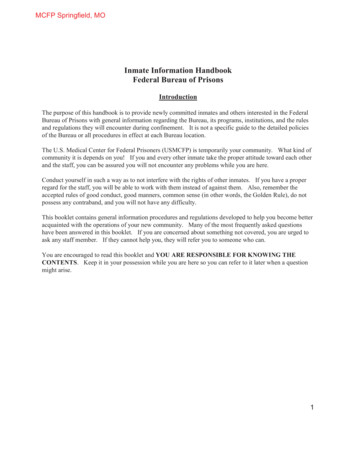


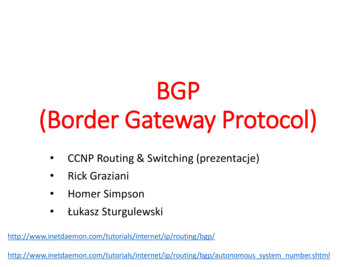

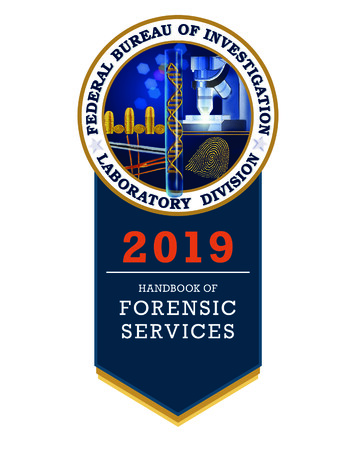
![[MS-OFBA]: Office Forms Based Authentication Protocol](/img/3/ms-ofba.jpg)
